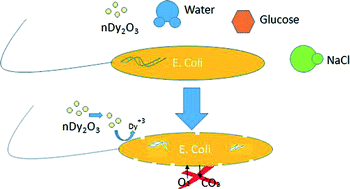Effects of dysprosium oxide nanoparticles on Escherichia coli†
Abstract
There is increasing interest in the study of dysprosium oxide nanoparticles (nDy2O3) for biomedical applications due to their fluorescence and paramagnetic properties. However, the fate of nDy2O3 and their effects on natural biological systems are a growing concern. This study assessed the toxicity of nDy2O3 on Escherichia coli for concentrations between 0.02 and 2 mg L−1, exposed to three concentrations of NaCl (8500, 850, and 85 mg L−1) and three glucose concentrations (35, 70, and 140 mg L−1). The ranges of these variables were selected to cover manufacturer recommendations of analytical methodologies for toxicity assessment, environmental and industrial nDy2O3 effluent concentrations, and metabolic activity. Two array-based toxicity techniques were used to evaluate the 27 combinations of conditions. Fluorescent dyes (Live/Dead) and respirometric assays were used to measure the undisturbed cell membrane (UCM) and remaining respiration percentage (RRP), respectively. Respirometric tests showed a higher toxic effect than Live/Dead test assays, indicating that metabolic processes are more affected than the physical structure of the cell by exposure to nDy2O3. After exposing the bacteria to concentrations of 2.0 mg L−1 uncoated nDy2O3 for 2 h at 85 mg L−1 NaCl and 140 mg L−1 glucose, the RRP and UCM decreased to 43% and 88%, respectively. Dysprosium ion (Dy+3) toxicity measurement suggested that Dy+3 was the main contributor to the overall toxicity.

- This article is part of the themed collection: Sustainable Nanotechnology Organization 2014

 Please wait while we load your content...
Please wait while we load your content...